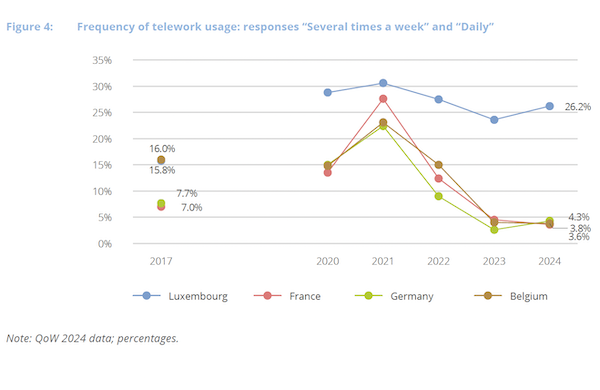 Credit: CSL
Credit: CSL
Luxembourg's Chamber of Employees (Chambre des Salariés – CSL) recently unveiled a new analysis highlighting the differences in well-being and working conditions between resident employees and cross-border workers.
The findings highlight disparities that are mainly due to differences in socio-demographic profiles, including levels of education, employment sectors and types of occupations, which vary significantly depending on country of residence.
According to the report, Belgian cross-border workers showed the highest education levels, with 58% holding a higher education diploma, compared to 55% of Luxembourg residents, 46% of French cross-border workers and 41% of German ones. There were also disparities depending on nationality. Only 28% of employees working in Luxembourg hold Luxembourgish nationality. Nevertheless, the CSL pointed out that the number of German cross-border workers becoming Luxembourgish nationals rose from 5% in 2014 to 10% in 2024. Sectoral differences were also notable: Luxembourg residents mainly work in the public sector, banking, insurance and healthcare, while French cross-border workers are more present in industry, commerce, ICT and services, and German cross-border workers are more active in construction, finance, insurance and the health sector. Belgian cross-border workers showed a mixed profile, with strong representation in both manual and intellectual professions.
Commute time remains a factor affecting job satisfaction, with notable differences between residents and cross-border workers. While 62% of Luxembourg residents commute less than 30 minutes, 66% of French cross-border workers report journeys longer than 46 minutes, followed by 53% of Belgian and 52% of German commuters. Satisfaction with commute time is higher among residents (60%) with just 16% reporting being dissatisfied, compared to 48% of French, 39% of Belgian and 31% of German cross-border workers who were dissatisfied.
The CSL identified teleworking as an option for managing commute-related constraints, although its overall use stabilised at 32% in 2024 (at least several times per month). Around 40% of Luxembourg residents regularly work remotely, compared to lower figures among cross-border workers: 24% of French, 22% of Belgian and 19% of German cross-border workers. More frequent teleworking (several times per week) has dropped more significantly, with only 4% of cross-border workers reporting regular use in 2024, compared to 23–28% in 2021. Among Luxembourg residents, this figure stands at 26% (down from 31% in 2021). Access to telework varies by sector and profession, remaining common in executive and intellectual roles but limited in fields such as construction and local services.
According to the CSL, perceptions of working conditions have declined over the past eleven years, as reflected in its Quality of Work Index measured on a scale from 0 to 100. In 2024, German cross-border workers in In 2024, German cross-border workers in Luxembourg reported the highest score (55.4), followed by resident employees (55.1) and Belgian cross-border workers (54.3). French cross-border workers recorded the lowest score, at 52.1.
Beyond differences in education, employment sectors and commuting, the CSL study also pointed to marked disparities in work quality, well-being and job satisfaction between Luxembourg residents and cross-border workers. French cross-border workers reported higher levels of burnout and physical health problems, while German workers showed lower motivation and below-average scores in overall well-being. In contrast, residents in Luxembourg expressed greater job satisfaction, and Belgian cross-border workers stood out for strong work motivation.
Structural factors such as mobility continue to influence these outcomes. Longer commutes, particularly among French workers, were linked to lower satisfaction and weaker work-life balance. The decline in teleworking since the end of pandemic-related measures has also disproportionately affected cross-border workers.
The CSL noted that while the intention to change jobs rose from 2016 to 2023 before slightly decreasing in 2024, Belgian cross-border workers were the most likely to consider a job change. German workers were the least affected by this trend. According to CSL, these disparities reflect not only geographical differences but a broader combination of socio-demographic, professional and structural factors.









